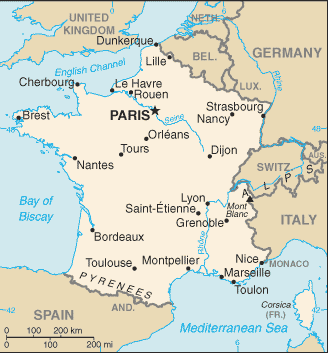French Republic
Related Categories:
 National Symbols of France
National Symbols of FranceLilly flower, Gallic Rooster, coq gaulois, independence day e-cards, wallpapers.
www.123independenceday
Origin of the French flag, Colours, Nickname.
www.fotw.us/
The French Republic is a democracy that is organised as a unitary semi-presidential republic. Its main ideals are expressed in the Declaration of the Rights of Man and of the Citizen. It is a developed country with the sixth-largest economy in the world.
en.wikipedia.org/
Since prehistoric times, France has been a crossroads of trade, travel, and invasion. Three basic European ethnic stocks--Celtic, Latin, and Teutonic (Frankish)--have blended over the centuries to make up its present population. France's birth rate was among the highest in Europe from 1945 until the late 1960s. Since then, its birth rate has fallen but remains higher than that of most other west European countries. Traditionally, France has had a high level of immigration. More than 1 million Muslims immigrated in the 1960s and early 1970s from North Africa, especially Algeria. About 85% of the population is Roman Catholic, 10% Muslim, less than 2% Protestant, and about 1% Jewish. In 2004, there were over 6 million Muslims, largely of North African descent, living in France. France is home to both the largest Muslim and Jewish populations in Europe.
Education is free, beginning at age 2, and mandatory between ages 6 and 16. The public education system is highly centralized. Private education is primarily Roman Catholic. Higher education in France began with the founding of the University of Paris in 1150. It now consists of 91 public universities and 175 professional schools, including the post-graduate Grandes Ecoles. Private, college-level institutions focusing on business and management with curriculums structured on the American system of credits and semesters have been growing in recent years.
The French language derives from the vernacular Latin spoken by the Romans in Gaul, although it includes many Celtic and Germanic words. Historically, French has been used as the international language of diplomacy and commerce. Today it remains one of six official languages at the United Nations and has been a unifying factor in Africa, Asia, the Pacific, and the Caribbean.
www.state.gov/r/
Introduction
About
Contact
Symbols in The News
Interpret this Symbol
AAC
African
AI
Alchemy
Alphabets
Ancient
Animal Symbolism
Architecture
Art
Articles
Astrology
Baha'i
Blissymbolics
Blueprint Symbols
Buddhist
Celtic Symbols
Cemetery
Chinese Symbols
Christian
Circle
City
Codes
Color
Conlangs
Crop Circles
Danger
Da Vinci Code
Designing Logos
Dictionaries
Dreams
Education
Egyptian Symbols
Electrical
Emoticons
Find Images
Fonts
Food
Fraternity
Hamsa
Healing
Heraldry
Hermetic
Highway Signs
Hindu
History
Hobo
Holiday
Icons
iConji
Islamic
Jain Symbols
Japanese, Kanji
Jewish
Justice
Law
Literary Symbolism
Mandalas
Map
Masonic
Math, Number
Meaning of Names
Medical
Middle East
Military
Miscellaneous
Money
Music
Mythology
Native American
Playing Cards
Power
Psychology
QiQiiKhu
Reiki
Religious
Runes, Norse
Sacred Geometry
Scientific
Science Fiction
Sorority
Sports
Symbols in the News
Tattoos
ThirteenSymbols
Tree of Life
Ursprache
Videos
Visual Languages
Weather
Web Codes
Wicca
Words
Writing Systems
Braille
Coinherence
Coptic
Cuneiform
Easter Island
Etruscan
Happy Human
Hebrew
Kokopelli
Linear B
Lotus
Love Symbols
Mandorla
Moon Alphabet
Nine Pointed Star
Om
Oz
Phonetic
Scarab Beetle
Silent
Theosophy
Unifon
About
Contact
Symbols in The News
Interpret this Symbol
AAC
African
AI
Alchemy
Alphabets
Ancient
Animal Symbolism
Architecture
Art
Articles
Astrology
Baha'i
Blissymbolics
Blueprint Symbols
Buddhist
Celtic Symbols
Cemetery
Chinese Symbols
Christian
Circle
City
Codes
Color
Conlangs
Crop Circles
Danger
Da Vinci Code
Designing Logos
Dictionaries
Dreams
Education
Egyptian Symbols
Electrical
Emoticons
Find Images
Fonts
Food
Fraternity
Hamsa
Healing
Heraldry
Hermetic
Highway Signs
Hindu
History
Hobo
Holiday
Icons
iConji
Islamic
Jain Symbols
Japanese, Kanji
Jewish
Justice
Law
Literary Symbolism
Mandalas
Map
Masonic
Math, Number
Meaning of Names
Medical
Middle East
Military
Miscellaneous
Money
Music
Mythology
Native American
Playing Cards
Power
Psychology
QiQiiKhu
Reiki
Religious
Runes, Norse
Sacred Geometry
Scientific
Science Fiction
Sorority
Sports
Symbols in the News
Tattoos
ThirteenSymbols
Tree of Life
Ursprache
Videos
Visual Languages
Weather
Web Codes
Wicca
Words
Writing Systems
Braille
Coinherence
Coptic
Cuneiform
Easter Island
Etruscan
Happy Human
Hebrew
Kokopelli
Linear B
Lotus
Love Symbols
Mandorla
Moon Alphabet
Nine Pointed Star
Om
Oz
Phonetic
Scarab Beetle
Silent
Theosophy
Unifon

